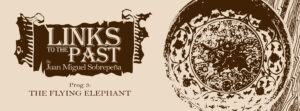Prog 3: THE FLYING ELEPHANT

One of man’s earliest milestones is the attempt to engage in organized trade with other civilizations to foster cultural and material exchanges with foreign communities. In the case of our pre-Spanish predecessor states, it appears that trade had been the main catalyst for their sea-faring activities. Ancient trade ships capable of long sea voyages, known as “balangay”, have been unearthed all over the archipelago – including that of the massive Butuan Mothership. Not only does this indicate that they were developed enough as a society to gather supplies, commodities, and other items for the purpose of international trade, they were also aware of the existence of their far-reaching neighbors and were ultimately interested in what they had to offer.
Trade is traditionally a two way agreement, and since it has been established that our ancestors were engaged in their own long distance trading activities, it should come as no surprise that other civilizations would send their own trade vessels back in return. In 1997, the discovery of an ancient Chinese shipwreck off of the Lena Shoal led to the finding of two of today’s most treasured Filipino cultural artifacts – San Diego’s astrolabe and a well-preserved porcelain dish referred to as “The Flying Elephant of Lena Shoal”. The dish itself is said to have been crafted during China’s Middle Ming Dynasty (circa 1500’s) and was specifically intended for an Islamic market, much like the ones in existence on these islands during pre-colonial times. It remains only one of two Flying Elephant porcelain designs ever to be found, making this an extremely rare and important piece not just for Philippine history, but the entire world.
The Flying Elephant of Lena Shoal is now held at the National Museum of the Philippines and stands as a reminder of an old world where our people were free to practice their own ways of life, blissfully unaware of the terrible invasion that was to come. How would our people have developed had the Spanish conquistadors never set foot on our soil? Perhaps, we would have spilled each other’s blood until united under a single banner, or maybe we would have learned to exist as separate, but related, nation-states. Unfortunately, we may never know the answer, as our shared cultural heritage was crushed underneath 333 years of foreign occupation – but at the very least, this should give us modern day Filipinos all the more reason to cherish the few fragments of history that we have left.
